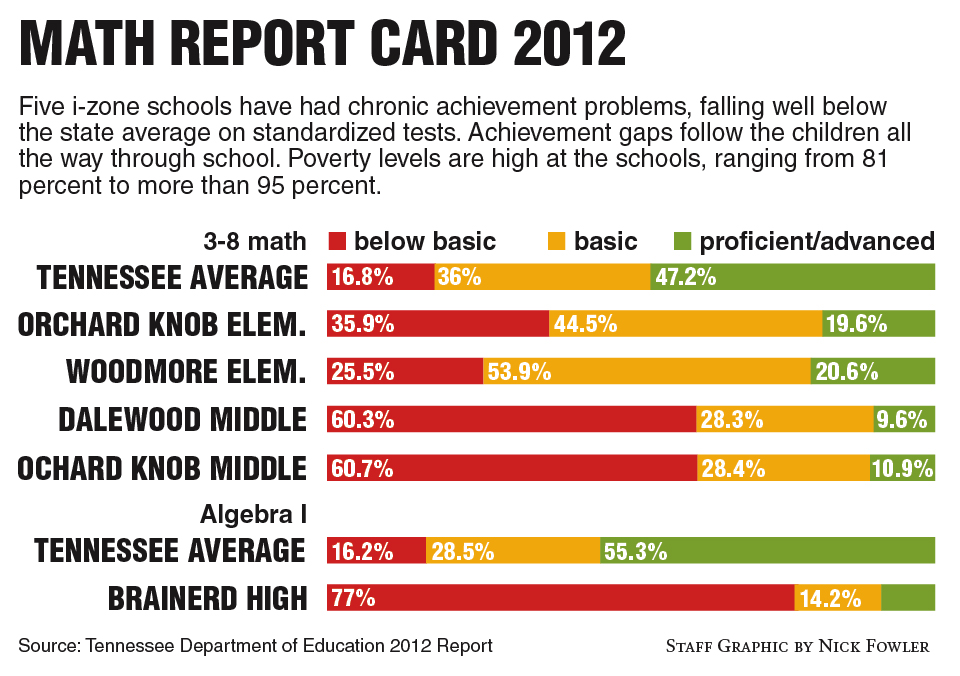Hamilton County's troubled schools still fall behind peers
Friday, January 1, 1904
 Teacher Henry Billen helps Devrin Houston, left, and Eriyuan Carter work on problems in seventh-grade math class at Dalewood Middle School, one of five Chattanooga schools that are listed as among the lowest-performing in the state. Hamilton County is creating a School Innovation Zone, but Dalewood is already implementing changes designed to motivate teachers and students.
Teacher Henry Billen helps Devrin Houston, left, and Eriyuan Carter work on problems in seventh-grade math class at Dalewood Middle School, one of five Chattanooga schools that are listed as among the lowest-performing in the state. Hamilton County is creating a School Innovation Zone, but Dalewood is already implementing changes designed to motivate teachers and students.The Tennessee Department of Education already had designated five Hamilton County schools among the worst-performing in the state.
But recently released data show just how far these schools have fallen.
While the county and state made steady improvement on standardized tests in 2012, Brainerd High, Dalewood Middle, Orchard Knob Elementary, Orchard Knob Middle and Woodmore Elementary remained relatively flat. And their scores were already well behind state and county averages.
Hamilton County Schools will apply for a state grant next month to create a local School Innovation Zone, or i-zone. If the application is approved, the county would be able substantially to alter school programming and operations in i-zone schools.
Aside from adding new teacher training and compensation programs, the county could choose to lengthen the school day and school year for those schools.
The county applied for a similar grant last year but was turned down. State officials gave the district $500,000 for a "planning year" to perfect the grant application.
New state Report Card data show Orchard Knob Elementary School made the most growth among i-zone schools, with average reading scores up 3 percent and math scores up 1.3 percent. Still, about 36 percent of students tested below basic skill levels in math. And reading scores showed only about 15 percent of students were prepared for their next level of study.
Other i-zone school report card results show:
• Fewer than 9 percent of Brainerd High students tested at grade level in math. In English, 18.5 percent of those tested met or exceeded standards.
• About half of Orchard Knob Middle students scored below basic on reading tests. Another 37.1 percent were in the basic category and 13.5 percent met or exceeded standards.
• Dalewood Middle scores dropped last year, with fewer than 10 percent of students reading at grade level and 13.8 percent meeting or exceeding math standards.
The results, which come as no surprise to local education officials, point to the monumental task at hand.
I-zone school leaders have set a goal of improving proficiency scores by 10 percent each year. That's lofty when compared to the 3 to 5 percent growth goals the state is setting for districts across the state.
"Because the schools are further behind, they have a stronger need to catch up," said Orchard Knob Elementary Principal LaFrederick Thirkill. "However, it should be easier for us to make the gains."
If the county receives the i-zone grant, which could be worth several million dollars, Thirkill hopes to add new technology to his building, hire more teachers at the primary grades and bring in interventionists to work with struggling students.
Thirkill noted that his school's population increased by almost 100 students last year and still had growth in test scores. But he said he realizes further growth is needed.
"Of course their skills are not where I want them to be," he said. "I want us to be out of the i-zone."
The five i-zone schools have had chronic achievement problems. And poverty levels are high, ranging from 81 percent to more than 95 percent. Achievement gaps will follow the children all the way through school.
"We're hoping that addressing the issue early in a child's life will certainly change the results for these schools," Superintendent Rick Smith said.
He said the i-zone schools may offer additional in hopes of stocking them with the highest-quality teachers possible.
"We know that one or two high-performing teachers is not necessarily going to change things," he said.
Dalewood Middle Principal Christian Earl said he's spent his first semester there focusing on boosting student and teacher morale. He's also added more diagnostic testing of students in literacy, implemented an after-school program and added more class time in core subject areas.
Earl is one of three new i-zone principals this year. To qualify for the grant, the system had to transfer principals who had been in charge of their schools for three years or longer. Dalewood, Woodmore and Brainerd had leadership changes this fall.
If the i-zone is successful, it has the potential to change the course for the entire community as historically low-achieving schools improve, said Hamilton County i-zone director Le Andrea Ware.
Because the schools are dealing with an inner-city, high-poverty and high-minority population, Ware said it's key for teachers and principals to first set high expectations and make real connections with students.
"Sometimes we have to believe in our children before they believe in themselves," she said.
